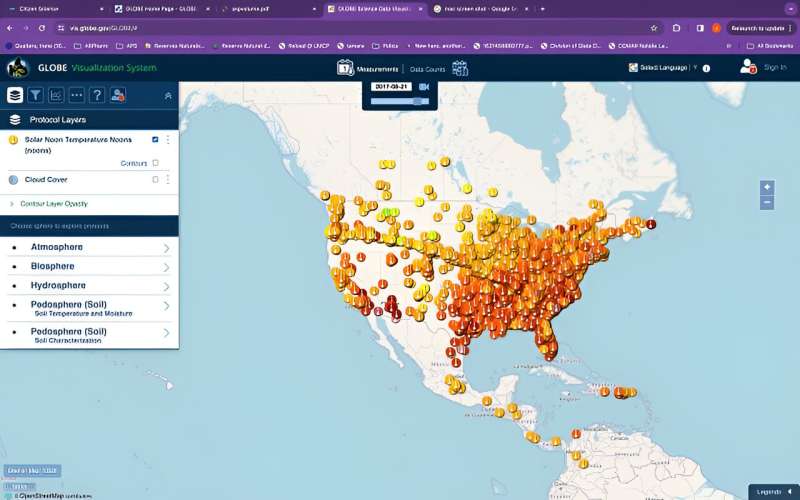An April 2, 2024 news item on phys.org is, in fact, an open invitation to participate in data collection for NASA during the April 8, 2024 eclipse,
On April 8, 2024, as the moon passes between the sun and Earth, thousands of amateur citizen scientists will measure air temperatures and snap pictures of clouds. The data they collect will aid researchers who are investigating how the sun influences climates in different environments.
Among those citizen scientists are the fifth- and sixth-grade students at Alpena Elementary in northwest Arkansas. In the weeks leading up to the eclipse, these students are visiting the school’s weather station 10 times a day to collect temperature readings and monitor cloud cover. They will then upload the data to a phone-based app that’s part of a NASA-led program called GLOBE, short for Global Learning and Observations to Benefit the Environment.
The goal, according to Alpena Elementary science and math teacher Roger Rose, is to “make science and math more real” for his students. “It makes them feel like they’re doing something that’s important and worthwhile.”
The GLOBE eclipse tool is a small part of the much broader GLOBE project, through which students and citizen scientists collect data on plants, soil, water, the atmosphere, and even mosquitoes. Contributors to the eclipse project will only need a thermometer and a smartphone with the GLOBE Observer app downloaded. They can access the eclipse tool in the app. [emphases mine]
…
An April 1, 2024 NASA article by James Riordon, which originated the news item, provides more information about the GLOBE program and the hopes for the April 8, 2024 eclipse initiative,
This is not the first time the GLOBE eclipse tool has been deployed in North America. During the 2017 North American eclipse, NASA researchers examined the relationship between clouds and air temperature and found that temperature swings during the eclipse were greatest in areas with less cloud cover, while temperature fluctuations in cloudier regions were more muted. It’s a finding that would have been difficult, perhaps impossible, without the assistance of numerous amateur observers along the eclipse path, said Marilé Colón Robles, a meteorologist based at NASA’s Langley Research Center in Hampton, Virginia, and the GLOBE project scientist overseeing the cloud study portion of the project.

The number of weather stations along this year’s eclipse path is limited, and while satellites give us a global view, they can’t provide the same level of detail as people on the ground, said Ashlee Autore, a NASA Langley data scientist who will be conducting a follow-up to the 2017 study. “The power of citizen science is that people make the observations, and they can move.”
It’s still unclear how temperature fluctuations during a total eclipse compare across different climate regions, Colón Robles said. “This upcoming eclipse is passing through desert regions, mountainous regions, as well as more moist regions near the oceans.” Acquiring observations across these areas, she said, “will help us dig deeper into questions about regional connections between cloud cover and ground-level temperatures.” The studies should give scientists a better handle on the flow of energy from the Sun that’s crucial for understanding climate.
In many areas, citizen scientists are expected to gather en masse. “We’re inviting basically all of El Paso to campus,” said geophysicist and GLOBE partner John Olgin of El Paso Community College in Texas. The area will experience the eclipse in near totality, with about 80% of the Sun covered at the peak. It’s enough to make for an engaging event involving citizen scientists from the U.S. and Juarez, Mexico, just across the Rio Grande.
Just a few minutes of midday darkness will have the long-term benefits of increasing awareness of NASA citizen science programs, Olgin said: “It’s going to inspire people to say, ‘Hey look, you can actually do stuff with NASA.’”
More than 30 million people live along the path of the 2024 eclipse, and hundreds of millions more will see a partial eclipse. It will be another 20 years before so many people in North America experience another total solar eclipse again.
With this in mind, Colón Robles has a piece of advice: As the Moon actively blocks the Sun, set your phone and thermometer aside, and marvel at one of the most extraordinary astronomical events of your lifetime.
Visit NASA’s Citizen Science page to learn how you can help NASA scientists study the Earth during eclipses and all year round. The GLOBE Program page provides connections to communities of GLOBE participants in 127 countries, access to data for retrieval and analysis, a roadmap for new participants, and other resources.
For anyone who wants to experience all of the ways that NASA has made their citizen science April 2024 eclipse projects accessible there’s NASA’s ‘general eclipse’ webpage.